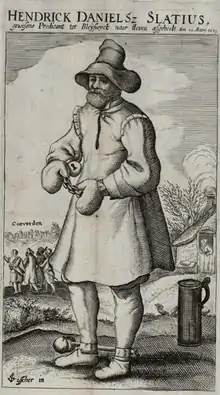Hendrick Danielsz Slatius
Hendrick Danielsz Slatius (Oosterland, 1585[1] – The Hague, 5 May 1623; also known as: Hendrik Slaet, Henricus Slatius) was a Netherlands remonstrant preacher and writer. He participated in a foiled plot to murder the Prince of Orange.
Hendrick Danielsz Slatius | |
|---|---|
 | |
| Died | 5 May 1623 |
Education
Slatius originally intended to be sent to Dutch East Indies as a preacher in the service of the Dutch East India Company (VOC). In 1603, the Heren XVII (central board of the VOC) "had ordered that one be informed after two suitable and qualified persons to nominate Godts Woorts, and the people against all superstition and the exuberance of the Moors and the Atheists through admonishment of the scriptures". However, in the period before the foundation of the Indian Seminary in 1622, the company continued to struggle to interest competent but also willing persons. Slatius was the first with whom a contract was signed in 1606. This stipulated, among other things, that the company would pay his theology studies at the University of Leiden and then leave for the Dutch East Indies in the service of the VOC. During his final exam in Middelburg, concerns were raised against Slatius because he was a proponent of Arminianism based on the ideas of Jacobus Arminius. In Utrecht he passed the exam, although he was advised to conform to the ideas of Gomarus. Slatius eventually decided not to go to the East.
Ministry and publications
Slatius became a Remonstrant minister in Bleiswijk. He made the Remonstrant doctrine sound loud and clear. After the Synod of Dordrecht, he was removed from office, after which he fled to Antwerp. He published several works from Antwerp.
Plot and betrayal
The execution of Oldenbarnevelt was a thorn in his side. Together with, among others, the brothers Willem and Reinier van Oldenbarnevelt, sons of Johan van Oldenbarnevelt, who was sentenced to death at the instigation of Maurice in 1619, he plotted an attempt on Maurice's life. In 1623 Slatius provided the weapons that would be used in the attack.[2] Claes Michielsz Bontenbal, secretary of Zevenhuizen, contributed to the financing.[3] The plot was betrayed and Slatius fled. He disguised himself in peasant clothes and fled via Amsterdam, Leeuwarden and Groningen to Drenthe. From there he wanted to escape to Germany. Seen some light, he enter in an inn in Rolde. Worried by the presence of soldiers, he settled his meal, but left the full jug of beer untouched. This raised suspicion among the soldiers, who followed and arrested him. Although he tried to save his life with excuses, it was discovered that he was the wanted Slatius, on whose head was put four thousand guilders. Slatius was brought to The Hague via Coevorden, Zwolle and Amsterdam.
Imprisonment and execution
.jpg.webp)
During his imprisonment, Slatius tried to avoid the death penalty by distancing himself from his Remonstrant views. When this vain hope turned out, he revoked this statement. He was sentenced to death after all. In his farewell letter to his wife, he wrote:[4] "My soul is abhorred by the Calvinists". He also instructs her to give the children a Christian education, but to show them how evil the Calvinists are, so that they will dislike it. Until execution of the death penalty, he was detained in the Gevangenpoort in The Hague.
An inscribed was made of the imprisoned pastor Slatius, dressed in peasant clothes and with handcuffs, by Claes Jansz Visscher (1587–1652), not only a skilled draftsman and etcher, but also a strict Calvinist.[5]
Notes and references
Citations
- "Hendrick Daniels Slatius". digitalebibliotheek.nl (in Dutch). Retrieved May 17, 2020.
- Lennep, J. van J. ter en Gouw, "" Considered the signs of history and folk life "" p. 385 (1868) ed. Kraay Amsterdam
- A. van Cruyningen, Attacks on Orange (2015), pp. 83–95.
- Deursen, A.Th. of Baboons and mudgies: church and people in the time of Maurits and Oldenbarnevelt 3rd edition (1998) publ. Van Wijnen, Franeker, ISBN 90-5194-067-X
- "Artists". Rijksmuseum (in Dutch). hdl:10934/RM0001.COLLECT.458325. Retrieved May 17, 2020.
Further reading
- Nijkeuter, Henk; Brood, Paul (2004). The history of Drenthe in more than 100 stories. Amsterdam: Van Gennep.